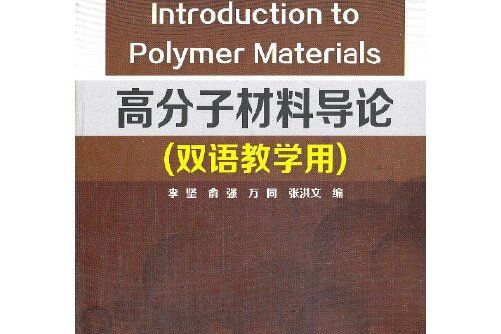《高分子材料導論(李堅)(雙語教學用)》是2014年化學工業出版社出版的圖書。本書作者是李堅,本教材共10章,有Introduction、Polpmer preparation 、Polymer structure、molecular motion and transition等。
基本介紹
- 書名:高分子材料導論(李堅)(雙語教學用)
- 作者:李堅
- 出版社:化學工業出版社
- ISBN:9787122192172
內容簡介,圖書目錄,作者簡介,
內容簡介
本教材共10章。1. Introduction (緒論)、2. Polpmer preparation (聚合物的製備)、3. Polymer structure,molecular motion and transition (聚合物結構、分子運動和轉變)、4. Polymer Properties(聚合物的性質)、5. Analysis and Testing of Polymers(聚合物表征和測試)、6. Plastics(塑膠)、7.Elastimers (彈性體)、8. Polymer Composites(聚合物基複合材料)、9. Coatings (塗料)、10 Recent developments in polymer science and technology(聚合物科學技術新進展)。
圖書目錄
Chapter 1 Introduction
1.1 Classification of polymerizations
1.1.1 Condensation and addition polymerization
1.1.2 Step and chain polymerizations
1.2 Classification of Polymers
1.2.1 Classification by source
1.2.2 Classification by mechanical behavior and application
1.2.3 Classification by synthesis reaction
1.2.4 Classification by chain structure
1.2.5 Classification by processing characteristics
1.3 Physical State, Property and Application of Polymers
1.3.1 Crystalline and amorphous behavior
1.3.2 Thermal transitions
1.3.3 General properties of polymers
1.3.4 Applications of polymer materials
1.4 Polymer Processing
1.4.1 Ingredients of polymer materials
1.4.2 Processing methods
1.5 Development of Polymer Science and Engineering
1.5.1 Brief history of polymer materials
1.5.2 Establishment of polymer science
1.5.3 The development of synthetic polymers
Problems
Chapter 2 Polymer Synthesis
2.1 Step Polymerization
2.1.1 Basis for analysis of polymerization kinetics
2.1.2 Kinetics of step polymerization
2.1.3 Molecular weight control in linear polymerization
2.2 Radical Chain Polymerization
2.2.1 Rate of radical chain polymerization
2.2.2 Molecular weight
2.2.3 Chain transfer
2.2.4 Inhibition and retardation
2.2.5 Process conditions
Problems
Chapter 3 Polymer Structure, Molecular Motions and Transitions of Polymers
3.1 General Introduction for Polymer Structures
3.1.1 Structural groups
3.1.2 Linear chain polymers
3.1.3 Configurations of polymer chains
3.1.4 Conformation
3.1.5 Copolymers
3.1.6 Network polymers
3.2 Characteristics of Macromolecular Motions and Transitions
3.2.1 The Glassy Region
3.2.2 The Glass Transition Region
3.2.3 The Rubbery Plateau Region
3.2.4 The Rubbery Flow Region
3.2.5 The Liquid Flow Region
3.3 Molecular Motion and Thermal Transitions
3.3.1 Theories of glass transition
3.3.2 Factors affecting glass transition temperature
3.3.3 The crystalline melting point
3.3.4 Factors affecting the crystalline melting point, Tm
Problems
Chapter 4 Solid State Properties of Polymers
4.1 Mechanical Properties
4.1.1 Forces Versus Deformation Properties
4.1.2 Toughness
4.1.3 Creep
4.2 Optical Properties
4.2.1 Haze
4.2.2 Transparency
4.2.3 Gloss
4.3 Surface Contact Properties
4.3.1 Friction
4.3.2 Cling
4.3.3 Wear Resistance
4.4 Barrier Properties
4.4.1 Permeation through Polymers
4.4.2 Barrier Property Analysis
4.5 Electrical Properties
4.5.1 Electrical Resistance
4.5.2 Capacitive Properties
4.5.3 Dielectric Strength
4.5.4 Arc Resistance
4.5.5 Corona Treatment
4.5.6 Factors Influencing Polymers in Electrical Applications
4.6 Weather Resistance
4.6.1 Natural Outdoor Weathering
4.6.2 Accelerated Outdoor Weathering
4.6.3 Artificial Weathering
Problems
Chapter 5 Characterization and Testing of Polymers
5.1 Gel Permeation Chromatography
5.1.1 GPC Instrumentation
5.1.2 Calibration
5.1.3 Selection and Assembly of Detectors
5.2 Infrared Spectroscopy
5.2.1 Instrument and Experimental Method
5.2.2 Applications to Polymers
5.3 X—ray Diffraction Analysis
5.3.1 Experimental Methods
5.3.2 Application to Polymers
5.4 Nuclear Magnetic Spectroscopy
5.4.1 Experimental Methods
5.4.2 Application to Polymers
5.5 Thermal Analysis
5.5.1 Thermogravity Analysis (TGA)
5.5.2 Differential Scanning Calorimetry (DSC)
5.6 Light and Electron Microscopy
5.6.1 Light Microscopy
5.6.2 Electron Microscopy
Problems
Chapter 6 Plastics
6.1 Polyethylene
6.1.1 Low Density Polyethylene (LDPE)
6.1.2 High density polyethylene (HDPE)
6.1.3 Linear low density polyethylene (LLDPE)
6.1.4 Ethylene—vinyl acetate copolymer (EVA)
6.1.5 Crosslinked polyethylene (XPE)
6.2 Polypropylene (PP)
6.2.1 Isotactic polypropylene
6.2.2 Syndiotactic polypropylene (SPP)
6.3 Polyvinyl Chloride (PVC)
6.3.1 Polymerization
6.3.2 Structure and Properties
6.3.3 Copolymers
6.3.4 Application
6.4 Polystyrene (PS) and Related Polymers
6.4.1 Polymerization of styrene
6.4.2 Structure and properties
6.4.3 Copolymers of styrene
6.4.4 Syndiotactic polystyrene (SPS)
6.4.5 Application
6.5 Polymethyl Methacrylate (PMMA)
6.5.1 Polymerization
6.5.2 Structure and property
6.5.3 Application
6.6 Polyamide (Nylon)
6.6.1 Polyhexamethylene adipamide (nylon—66)
6.6.2 Other important polyamides
6.7 Polyethylene terephthalate (PET)
6.7.1 Polymerization
6.7.2 Property and application
6.8 Polyoxymethylene (POM)
6.8.1 Polymerization
6.8.2 Property
6.8.3 Application
6.9 Polycarbonate (PC)
6.10 Polytetrafluoroethylene (PTFE)
6.10.1 Polymerization
6.10.2 Structure
6.10.3 Property
6.10.4 Effect of structure on property
6.10.5 Fabrication and processing
6.10.6 Application
6.10.7 Fluorocarbon copolymers
Problems
Chapter 7 Elastomers
7.1 Basics for Elastomers
7.2 Morphology of Thermoplastic Elastomers
7.2.1 General characteristics
7.2.2 Properties and effect of structure
7.2.3 Mechanical properties
7.2.4 Thermal and chemical properties
7.3 Diene Elastomers
7.3.1 Butadiene—based elastomers
7.3.2 Polyisoprene
7.3.3 Polychloroprene
7.3.4 Styrene —butadiene rubber (SBR)
7.3.5 Metathesis elastomers
7.3.6 Nondiene elastomers
7.3.7 Thermoplastic elastomers
Problems
Chapter 8 Polymer Composites
8.1 Introduction to Composites
8.2 A Brief History of Polymer Composites
8.3 General Use Considerations
8.4 Technology Overview
8.4.1 Reinforcements
8.4.2 Matrices
8.4.3 Coupling agents
8.4.4 PMC forms
8.4.5 Fabrication processes
8.5 Applications of Polymer Composites
8.6 Nanocomposites
8.7 View of the Future
Problems
Chapter 9 Paint and Coatings
9.1 Principles of Coating
9.1.1 Rheology
9.1.2 Viscosity behavior
9.1.3 Surface chemistry
9.2 Composition of Paint
9.2.1 Introduction
9.2.2 Binder
9.2.3 Pigments
9.2.4 Solvents
9.2.5 Additives
9.2.6 Fillers (Extenders)
9.3 Theory of Adhesion
9.3.1 Introduction
9.3.2 Mechanical bonding
9.3.3 Electrostatic attraction
9.3.4 Chemical bonding
9.3.5 Paint diffusion
9.4 Coating Materials
9.4.1 Acrylics
9.4.2 Alkyd resins
9.4.3 Epoxies
9.4.4 Polyurethanes
Problems
Chapter 10 Developments in Polymer Science and Technology
10.1 Synthesis Technology
10.1.1 Living radical polymerization
10.1.2 Living cationic polymerization
10.2 New Polymer Materials and Applications
10.2.1 Dendritic (highly branched) polymers
10.2.2 Conducting Polymers
10.2.3 Bio—degradable polymers
Problems
References
作者簡介
李堅,常州大學材料科學與工程學院,院長 教授,合肥工業大學,本科畢業。華東化工學院(華東理工大學)碩士畢業。日本大阪大學,獲博士學位。
工作及研究經歷:
1988,7— 2000,12;常州大學(江蘇化工學院),材料工程系工作。教學與科研。副教授。高分子教研室主任。教授的課程有:高分子化學,功能高分子,專業英語,離子交換樹脂等。研究方向:水性聚氨酯,聚丙烯酸酯等粘合劑的研究;大分子過氧化物的研究。
2001,1—2001,12; 英國劍橋大學 (Melville Laboratory for Polymer Synthesis, University of Cambridge)訪問學者。研究方向:聚合物發光材料的合成及性能研究(PLED);聚芴的合成。導師:Andrew B Holmes (聚合物(PPV)發光的發現者之一)。
2002,1—2007,3;日本三洋電機株式會社研究本部工作。研究方向:聚合物發光材料的合成及性能研究(PLED);有機TFT的研究;有機太陽能電池的研究;聚芴及其共聚物的合成。
2007,3--- 至今,常州大學材料科學與工程學院材料化學教研室工作。教授。教學與科研工作。主要研究方向:聚合物有機半導體的合成與性能研究;利用ATRP製備聚丙烯酸酯嵌段共聚物及其套用;塗料粘合劑的研發。
主要科研成果:
長期從事有關聚合物發光(PLED),有機TFT,有機太陽能電池及水性聚氨酯的研究。參加過多項省部級科研項目的研發工作。發表論文:在國內外雜誌上發表相關論文幾十篇。專利:獲得美國,日本及中國有關聚合物發光材料(PLED),有機TFT及有機太陽能電池的專利共15件, 其中已公開的有 9 件。
教學工作:
長期從事教學工作,主講了高分子化學、功能高分子材料、離子交換樹脂、高分子專業外語、高分子材料導論(雙語)等課程。

